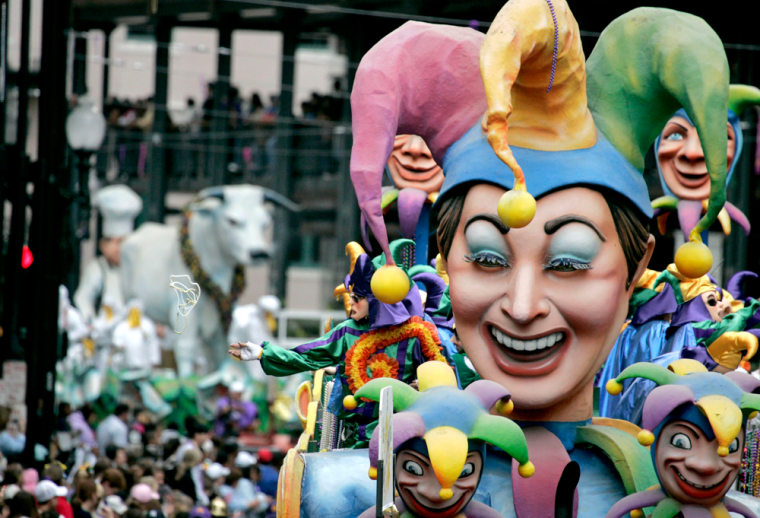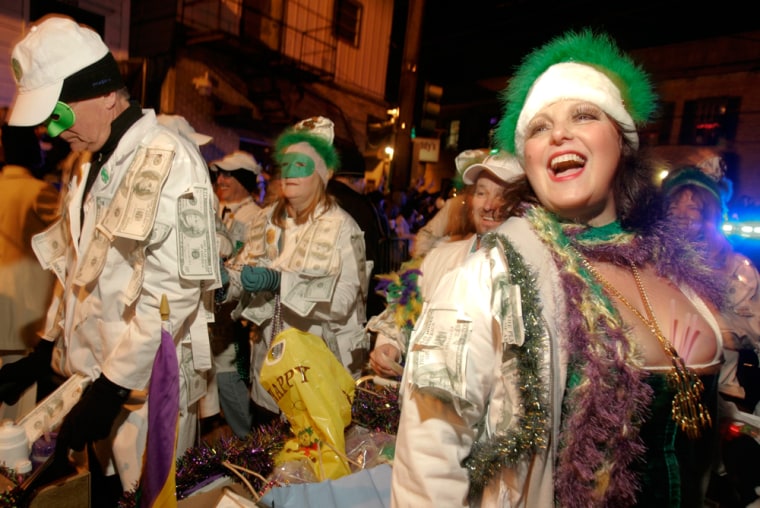In a town known for its music clubs, all-night bars and liberal public-drinking policy, Mardi Gras is the party that tops them all. As New Orleans continues to rebuild after Hurricane Katrina, its spirited residents and visiting revelers find ample reason to celebrate—proving that even one of America's worst natural disasters couldn't spoil the fun.
Watching the parades
Around 60 parades are held during Carnival season, each one hosted by a private organization, or "krewe." Most parades take place in the final 10 days leading up to Fat Tuesday, "Mardi Gras" in French. The big day always falls in February or early March, on the eve of Ash Wednesday, the beginning of the fasting season of Lent for many Christians. Minor parade schedule changes are common; go to mardigras.com for the latest info.
Warning: Do not flash body parts in the hopes of encouraging float riders to throw beads, stuffed animals, or other treats. Police zealously crack down on risqué behavior along parade routes. (The exception is the French Quarter. While flashing is still illegal there, it rarely draws even a verbal warning from cops.) A poster saying your hometown LOVES NOLA should do the trick in getting the attention of the folks throwing beads.
There are a few must-see parades. Endymion is a large parade with the most "throws," as well as Mardi Gras's longest float, the blocks-long Captain Eddie's S.S. Endymion (Saturday before Fat Tuesday, 4:15 p.m.). At Bacchus, a major celebrity serves as monarch—in 2007, it was James "Tony Soprano" Gandolfini (Sunday before Fat Tuesday, 5:15 p.m.).
Krewe of Orpheus is a music-based parade founded by Harry Connick Jr. One of the signature floats is Leviathan, a smoke-breathing dragon lit with fiber optics (Monday before Fat Tuesday, 6 p.m.). The most prized of all throws are the painted coconuts at Zulu, a century-old African-American celebration that began as a parody of elite white krewes (Fat Tuesday, 8 a.m.). Named for the King of Carnival, Rex includes the reading of the official Carnival proclamation and floats like Boeuf Gras, a huge white bull surrounded by chefs (Fat Tuesday, 10 a.m.).
There are also smaller parades worth seeking out. Muses is an all-female affair at which participants toss pumps and teddy bear beads (Thursday before Fat Tuesday, 7 p.m.). At Barkus, thousands of dogs march in themed costumes, while a family-oriented block party rages in Louis Armstrong Park before, during and after the parade (second Sunday before Fat Tuesday, 2 p.m.). Krewe du Vieux is an over-the-top spectacle with satirical, often raunchy floats; genitalia and sex are common themes (third Saturday before Fat Tuesday, 6:30 p.m.).
Party guide
It's legal to stroll the streets of New Orleans while drinking alcohol, and bars often have sidewalk-service windows. Glass containers aren't allowed outside, however; if you want to leave a bar with your drink, request a plastic "go-cup." The Hurricane, New Orleans's signature drink, packs a wallop with four shots of high-octane rum. Bars charge about $6, though prices go as high as $11 for a 32-ounce concoction in a souvenir jug. Side-street grocery and convenience stores sell liquor, beer, and other beverages. Some Mardi Gras vets carry small coolers or jugs as they wander the Quarter.

Many bars have balconies over Bourbon Street. Expect to pay $5 to $20 to perch on one, with time limits at the lower prices.
G-rated fun?
Families can—and do—attend Mardi Gras. One of the parade-watching areas where kids are plentiful and bawdy behavior is frowned upon is a wide grassy area on St. Charles Avenue, under oak trees in the upper Garden District. Views of the night parades, with their lighted floats, are beautifully framed by the huge arching trees.
Where to stay
Hotels on or near Canal Street are within easy reach of popular parade routes and the French Quarter. Try the Doubletree Hotel New Orleans (300 Canal, 504/581-1300, double rooms from $184 in low season) or, for a room on a quiet courtyard, the Dauphine Orleans (415 Dauphine, 504/586-1800, double rooms from $99 in low season). Book at least three months in advance, earlier if you hope to snag a balcony. One caveat: room rates can be twice as high, or more, during the Mardi Gras season.
